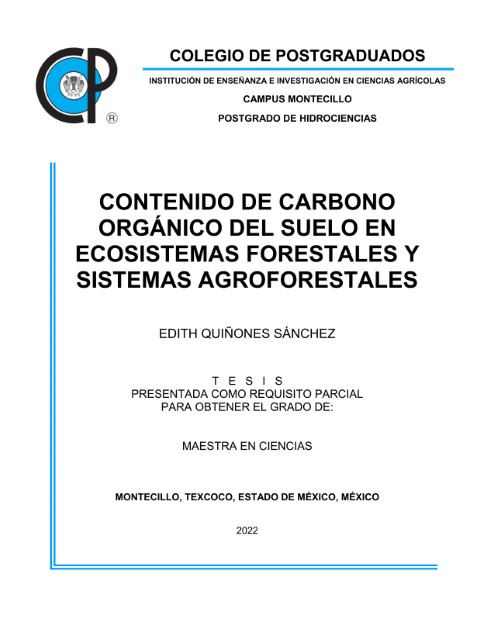
EDITH QUIÑONES SÁNCHEZ , M. C. Colegio de Postgraduados, 2022
RESUMEN
Los bosques del mundo son importantes reservorios de carbono (C); pero su capacidad de almacenamiento se está perdiendo debido a procesos de deforestación, degradación de los ecosistemas forestales y cambios de uso del suelo causados por actividades antropogénicas. El presente trabajo aporta información sobre la capacidad de almacenamiento de carbono orgánico del suelo (COS) en la Sierra Madre de Chiapas (SMC), principalmente en sistemas de producción de café bajo sombra de vegetación natural y cultivo de maíz. El COS se estimó de 0 a 30 cm de profundidad. La vegetación secundaria arbórea de la selva mediana perennifolia tuvo la mayor reserva de COS (103.22 Mg ha ); el cultivo de maíz reportó un contenido de 31.25 Mg C ha -1 ) y el bosque de pino-encino la menor (26.86 Mg ha -1 . En sistemas productivos de café, el rústico obtuvo la mayor reserva (113.23 Mg ha -1 ) y el monocultivo bajo sombra la menor (71.159 Mg ha -1 ). Se propuso un modelo en función los contenidos de C que explicó el 23.59% de la variabilidad en el contenido de COS en estos sitios. Las variables con mayor influencia fueron el almacén de C de la capa de hojarasca y la altitud. También se comparó la capacidad de almacenamiento de COS de ecosistemas forestales con la de otros usos de suelos en la región forestal de Texcoco, Estado de México. Se clasificó a la vegetación como: fase 1 a los usos de suelo y vegetación primaria o no perturbada, fase 2, modificados con diversa perturbación, y fase 3, producto de actividades antropogénicas como la agricultura, plantaciones forestales y de árboles frutales. Se encontró la mayor reserva de COS en los sitios con menor perturbación antropogénica, los ecosistemas forestales presentaron hasta tres veces más COS en comparación con los usos de suelo de la fase 3; los bosques de coníferas resultaron ser los más grandes reservorios de COS en comparación con los ecosistemas agrícolas.
Palabras clave: Almacén de carbono, Almacenes de carbono, Deforestación, Ecosistemas forestales, Uso del suelo, Perturbación antropogénica.
SOIL ORGANIC CARBON STOCKS IN FOREST ECOSYSTEMS AND AGROFORESTRY SYSTEMS.
Edith Quiñones Sánchez, M. C. Colegio de Postgraduados, 2022.
ABSTRACT
ABSTRACT The forests are important carbon stocks in the world, but its storage capacity is being lost due to deforestation, degradation, and land-use change caused by anthropogenic activities in forest ecosystems. The stock corresponding to soil organic carbon (SOC) represents more than 40% of the total stock in forests, being in many cases the most important stock in these ecosystems. The present research provides information on soil organic carbon (SOC) sequestration capacity in Chiapas Sierra Madre (SMC) locations, mainly in coffee production systems under natural vegetation shade and in maize cultivation. SOC was estimated from 0 to 30 cm depth, the medium evergreen forest secondary treed vegetation had the highest SOC stock (103.228 Mg ha ) and the pineoak forest the lowest (26.868 Mg ha -1 ); whereas a maize crop presented a C stock of 31.257 Mg ha -1 ) and the shaded monoculture had the lowest (71,159 Mg ha -1 , the rustic system had the highest stock (113,231 Mg ha -1 ). A model was suggested as a function of the C stock, which explained 23.59% of the variability in the SOC stock in the sample sites. C stocks in the mulch layer and the elevation were the most statistically significant variables. We also compared the COS storage capacity of forest ecosystems and with that of other land uses in the State of Mexico forest region III, where vegetation was classified by phase 1, land uses and primary or undisturbed vegetation, phase 2, with secondary vegetation, modified by diverse disturbances and, as phase 3, resulting from human activity, the highest COS stock was found in phase 1 (67.2 Mg C ha -1 ), followed by phase 2 (58.6 Mg C ha- -1 ). The primary oyamel forest had the highest COS stock with 83.6 Mg C ha 1 ) and phase 3 (22.9 Mg C ha -1 -1 , followed by cedar forest (70.6 Mg C ha - 1 ) and pine forest (57.7 Mg C ha- 1 ); the lowest were coniferous shrubland (3.1 Mg C ha - 1 ), cultivated forest (13.1 Mg C ha- 1 ) and irrigated agriculture (13.3 Mg C ha -1 ).
Key words: Agroforestry systems, Estimation, Deforestation, Forestal zones, Land use.
Fecha: 2022-10
Estudiante: EDITH QUIÑONES SÁNCHEZ
MAESTRÍA EN CIENCIAS - HIDROCIENCIAS
Consejo Particular:
Consejero: Dr. Martín A. Bolaños González
Asesor: Dr. Adolfo López Pérez
Asesor: Dr. Aurelio Báez Pérez